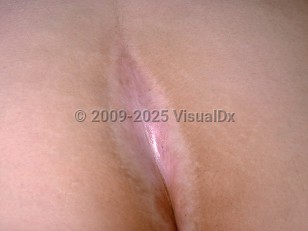Lichen sclerosus in Adult
See also in: External and Internal Eye,AnogenitalSynopsis

The pathogenesis of LS is unknown, but an autoimmune mechanism with genetic predisposition is hypothesized, with an increased prevalence of HLA-DQ7, DQ8, DQ9, and DR12. Some studies implicate Borrelia spp and Epstein-Barr virus (EBV) infection, and trauma and hormonal influences have been investigated. LS has also been reported in the setting of immune checkpoint inhibitor therapy.
Over 85% of lesions are found on anogenital skin. In this location, LS usually presents as dry, tender, and severely pruritic atrophic white plaques. In females, characteristic sites include the clitoris and clitoral hood, interlabial sulci, labia minora, and perineum. Plaques can progress to cause agglutination of labia minora to adjacent mucosa, and phimosis of the clitoral hood to the clitoris. Sclerosis of the vaginal introitus, with resultant dyspareunia, can also occur. Secondary erosion or ulceration may lead to burning and pain, especially after micturition.
The majority of cases of male genital LS occur in uncircumcised men. The glans and prepuce are most frequently affected. Meatal involvement may occur. Scarring complications include urinary obstruction, ulceration, painful erection, and phimosis. There may also be diminished sensation of the glans and sexual dysfunction.
Squamous cell carcinoma can arise in untreated genital lesions.
LS may also occur on extragenital skin and rarely on the oral mucosa. The Koebner phenomenon, with development of LS at sites of trauma, has been reported. Extragenital LS is frequently asymptomatic; however, it can be pruritic.
Codes
L90.0 – Lichen sclerosus et atrophicus
SNOMEDCT:
895454001 – Lichen sclerosus
Look For
Subscription Required
Diagnostic Pearls
Subscription Required
Differential Diagnosis & Pitfalls

Subscription Required
Best Tests
Subscription Required
Management Pearls
Subscription Required
Therapy
Subscription Required
Drug Reaction Data
Subscription Required
References
Subscription Required
Last Updated:07/27/2025
 Patient Information for Lichen sclerosus in Adult
Patient Information for Lichen sclerosus in Adult- Improve treatment compliance
- Reduce after-hours questions
- Increase patient engagement and satisfaction
- Written in clear, easy-to-understand language. No confusing jargon.
- Available in English and Spanish
- Print out or email directly to your patient


